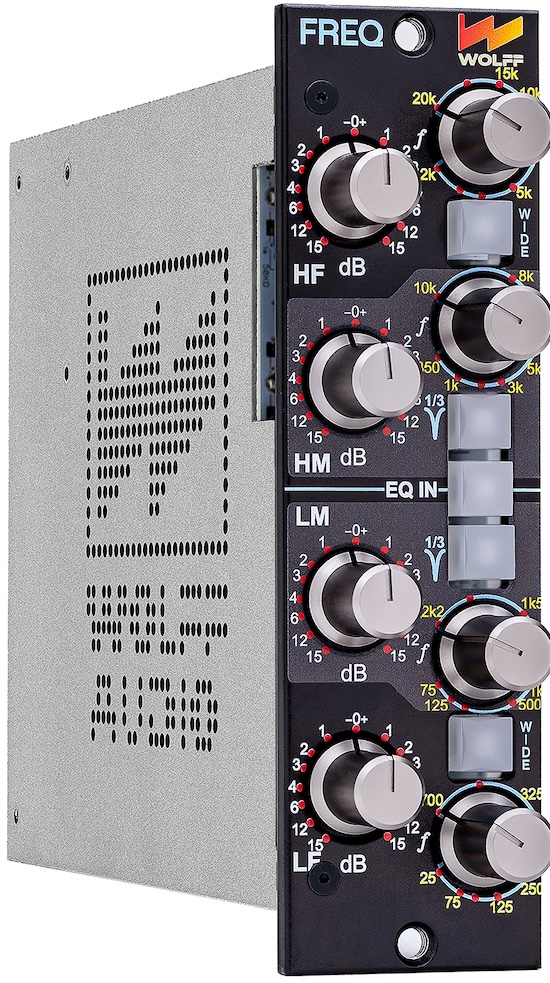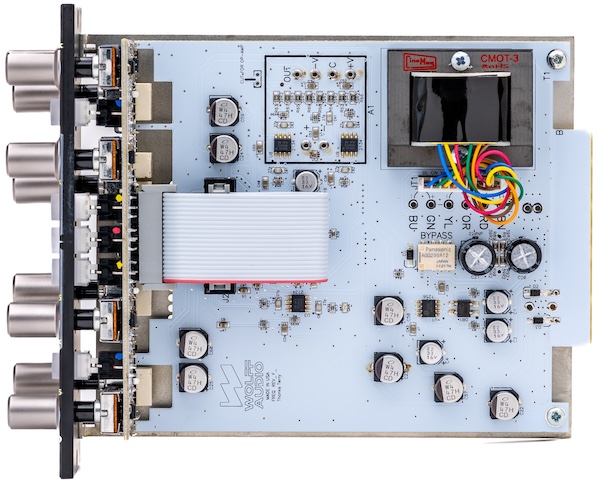
Barry's Mix Magazine Equipment And Software Reviews
Barry's Massive Discography And Engineering Career
Barry's Music Connection Magazine Reviews
Barry's Resolution Magazine Reviews
Wolff Audio Freq Equalizer
Four-Band Proportional-Q 500 Series Module
By Barry Rudolph
 |
| Close Up Of Wolff Audio's Freq Equalizer Front Panel |
The Freq Equalizer 500 Series module from venerable designer Paul Wolff offers a unique take on the four-band proportional-Q equalizer. He calls it an "everything EQ," useful in all equalization applications, from subtle and very smooth tonality changes, to a precision tracking EQ for solving problems by using deep, 1/3 octave, hi-Q notches, or when you're looking to apply more "colorful" boost/cut effects.
The Q of a proportional-Q equalizer tracks the amount boost or cut applied. Big boosts/cuts causes the Q's width to narrow while less boost/cut will widen out. All four bands are proportional-Q equalizers, with the high and low-frequency sections switchable to very low Q bell-shaped curves, Wolff's version of a shelving EQ.
Internal Details
The Freq Equalizer uses a custom Cinemag blended nickel/steel core output transformer; it's specified at +28 dBu maximum output. The make-up amplifiers driving the transformer are a custom quad power circuit using four, OPA2134s,which can be modified with discrete op-amp modules, if preferred. (such the Capi CA-0252 or the soon to be available, Wolf Audio op-amp modules). Freq has a bypass switch mounted between the 1/3 octave switches on the HM and LM sections. All switches on the Freq trigger relays for extended life--it's goodby forever to noisy, crackly switches. Also with no power applied to your 500 rack, the Freq EQs still passes audio in bypass.
Collection Of Controls
Freq's front panel controls are familiar to any engineer/producer who has worked with single-slot 500 Series modules, with its four, continuous frequency controls and four boost/cut knobs.
Starting from the top is a high-frequency shelving-like EQ section that is variable from 2kHz, at full clockwise, to 20kHz at counter-clockwise, with up to +/- 15dB boost/cut. The companion low frequency section EQ, also with +/- 15dB boost/cut, has a frequency range of 25Hz full CW, and up to 700Hz at CCW. Both high and low bands are 1/3-octave with boosts/cuts up to 15dB.
I like that the boost/cut controls on all four bands have solid-feeling, center-detents at 0dB and, selecting the desired frequency, from high to low, gives the same assurance. This consistency makes these controls easy to find and adjust in the dim lighting of the studio. In my control room, I have them in an eight-slot, Wolff Audio Bucket rack at arms-length away from the mix position, making them easy to adjust while I remain between my monitors.
Wide Mode
One of the Freq's unique features involves the blue-lit Wide buttons for both the high and low EQ sections. When switched in, those sections' proportional-Q EQs become 2.5-octave-wide, fixed Q, bell-shaped equalizers. You can instantly audition between a wide peaking equalizer and a proportional-Q EQ at the same frequency. I found this feature to make Freq an excellent tracking unit when recording drums and vocals. You have options!
In Wide mode with a fixed Q, big boosts or cuts are gently rolled-off starting at the EQ's center frequency. This prevents the unwanted boosts (using a traditional shelf) of super-high or super-low frequencies from clipping Freq's output and/or the following processors in the chain after it. You may not immediately hear this distortion
The Important MidRange
The mid-range frequencies are split into two sections that overlap both the High and Low sections. The High Mid-range section, or HM sits just below the high-frequency and has a range of 350Hz at full CW to 10kHz. Directly below HM is the Low Midrange, or LM, that goes from 75Hz to 2kHz. Both sections have their own fixed- Q 1/3rd octave switches, with the default position (switch not lit) being proportional-Q.
When the 1/3 notch buttons are engaged on either mid-range section, the Q changes to a fixed 1/3 octave, making them useful for setting a notch at a specified frequency. Because the two mid-range sections overlap each other, as well as the Hi and Lo EQs, it is possible to cut one frequency and boost the same frequency at the same time, the cut being narrow and the boost being wide. This is like an old Pultec EQ trick familiar to veteran engineers.
 |
| Under The Hood of the Freq Proportional-Q 500 Series Equalizer |
Kick
I first brought up the Wolff Freq Equalizer for a kick drum track in a mix. The drum did not "mesh" well with the bass guitar, which was double-tracked with an octave up, fuzz bass. I wanted the kick to have more subsonic push without sounding boomy.
On the kick track, I boosted 2 to 3dB at about 30Hz using Wide mode, and also in Wide mode in the HF section, I added 2 to 3dB at 5K for a little brighter, beater attack. I followed Freq with an UREI 1176LN with fast Attack and Release and a 4:1 ratio, its meter reading 3-5 dB of maximum gain reduction. The biggest help came from the Freq's Low Mid-range section where a deep, 1/3-octave 10dB notch at 1.2kHz cleared out some space to allow the other bass' fuzz tone to be heard. I could "tune in" this notch easily as it sliced through the kick drum's cardboard sound.
Lead Vocals
Next, I wanted to see how Freq handled lead vocals. I used two Freqs on the lead vocal track and another on a copy (multiple) of the same vocal. One of the problems was to figure out the big tonal difference when the singer switched from a natural male vocal range, which sounded dark in the verses but tended to be shrill when he went to full voice in the choruses. After the verse and chorus vocals were moved to individual tracks, I roughly-automated levels and the channel-switching.
For the choruses, Freq #1 HM section in Wide mode was excellent in locating a pesky, harsh midrange peak frequency in the choruses and then switching it to a 1/3 octave notch at 3kHz. I also added a +2dB starting at 10kHz Wide, just above the "S" area using Freq #1. But I could not leave that EQ on during the verses.
Freq #2 was for the dark-sounding verses, where I kept the 10kHz Wide but less of it. I used the LF section for a high-pass filter starting at 200Hz set to -2dB. The dark sound was solved by using the two mid-range sections with the LM section cutting about 1.5dB at 500Hz and the HM section boosting about 2dB at 3kHz.
All this processing might sound excessive, but by using broad, low Q peaking EQs and minimal wide boosts, the result is a new clarity and forward sounding lead vocal that could take one a following compressor or limiter well.
Stereo Bus
I wanted to try setting up a pair Freqs as a stereo bus equalizer. For me, a stereo EQ on the stereo bus is a sacrosanct position with the responsibility of finalizing and shaping the entire mix's sound. I usually place it before the stereo compressor, especially when readying a mix for mastering, streaming or mix approval.
A well-mixed song with good performances and well-recorded instruments needs only subtle polishing. The Freq's four bands could start with gentle high and low proportional boosts. The two mid-range sections are useful for scooping out or bringing up the mid-range or boosting frequencies with very broad bell-shaped EQ curves. Paul Wolff's Freq Equalizer 500 Series Module is the Everything EQ, I would recommend a pair of them any time to any one.
|
|
|
|
|